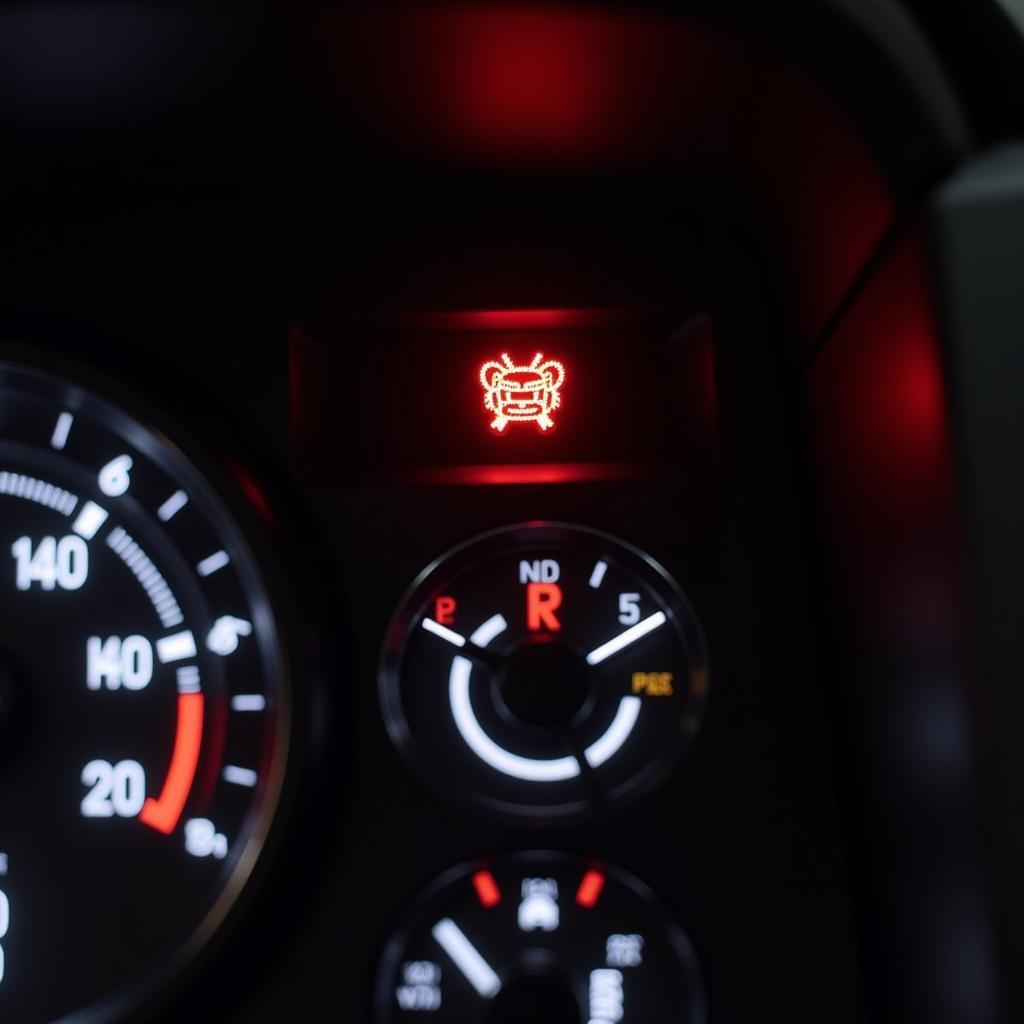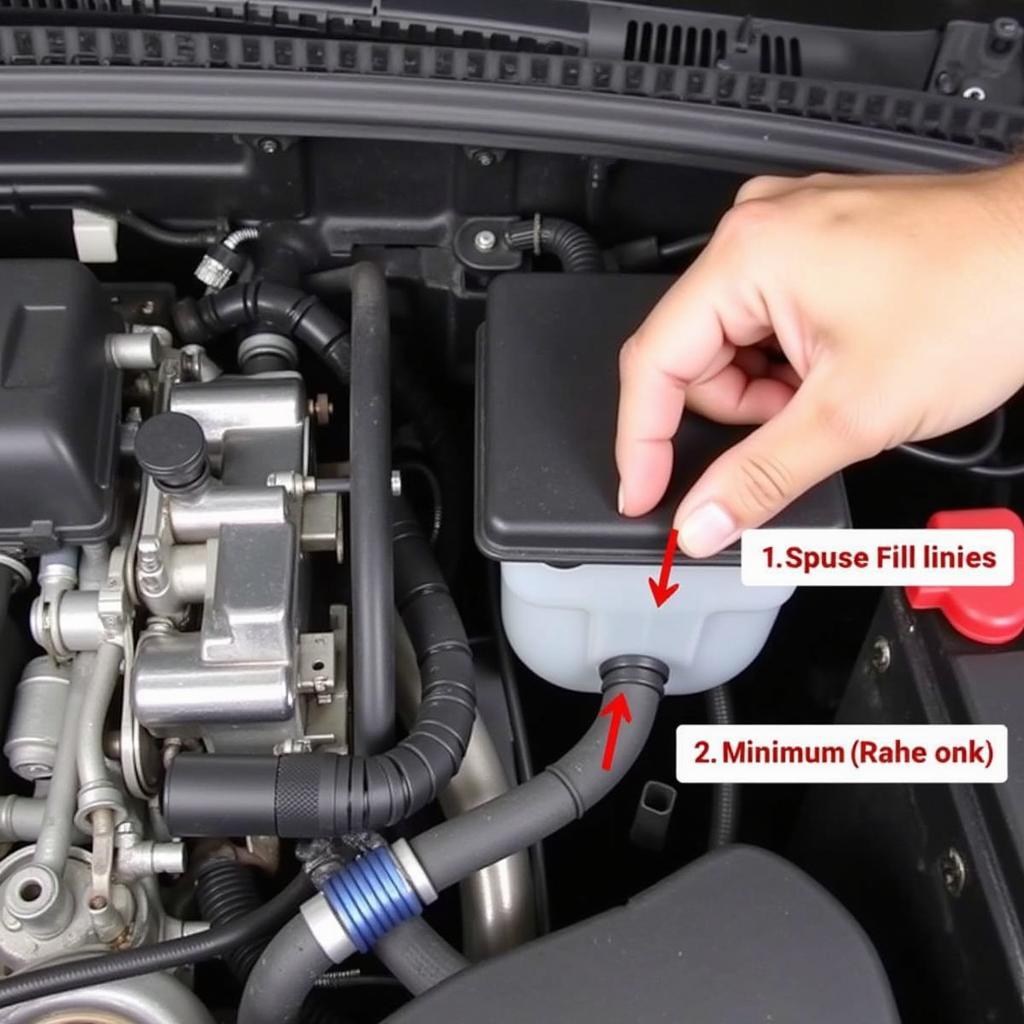The dreaded f150 brake system warning light can be a real headache. Seeing this light illuminate on your dashboard can signal anything from a minor issue to a serious problem requiring immediate attention. This comprehensive guide will walk you through the common causes, diagnostic procedures, and potential solutions for when your F150’s brake system warning light decides to make an unwelcome appearance.
 F150 Brake System Warning Light Illuminated on Dashboard
F150 Brake System Warning Light Illuminated on Dashboard
One common culprit behind a glowing brake system warning light is low brake fluid. Your brake system operates hydraulically, relying on brake fluid to transmit pressure from the pedal to the brakes. A leak in the system or worn brake pads can lead to low fluid levels. If you find yourself in this situation, topping off the brake fluid might be a quick fix. However, it’s important to new truck battery keeps dying check for leaks and address any underlying issues.
Understanding the F150 Brake System Warning Light
The brake system warning light isn’t just a single indicator; it can represent several underlying issues. This light can be triggered by low brake fluid, a faulty parking brake, a problem with the ABS system, or even a malfunctioning brake light switch. Diagnosing the exact cause requires a systematic approach.
Why is My F150 Brake System Warning Light On?
Several factors can trigger the brake system warning light. Identifying the root cause is essential for effective repair. Is your parking brake engaged? Sometimes, the simplest explanation is the correct one. A partially engaged parking brake can illuminate the warning light.
- Low brake fluid: This is often the most common cause.
- Worn brake pads: Thin brake pads require more fluid, potentially triggering the light.
- Faulty ABS sensor: A malfunctioning ABS sensor can disrupt the brake system’s operation.
- Brake light switch issues: A faulty switch can affect both the brake lights and the warning light.
 Checking the Brake Fluid Reservoir in an F150
Checking the Brake Fluid Reservoir in an F150
Diagnosing the Problem
Start with a visual inspection. Check your brake fluid reservoir. A low fluid level is a clear indicator of a potential leak or worn brake pads. Next, inspect your brake lines for any signs of leakage or damage. If you suspect an ABS issue, a diagnostic scan tool can pinpoint the specific fault code. Don’t forget to check your brake lights; a faulty brake light switch can be the unexpected culprit behind the warning light.
How to Check Your F150’s Brake Fluid
Locating and checking your brake fluid is a crucial first step. The brake fluid reservoir is typically located near the firewall on the driver’s side. Open the reservoir cap and check the fluid level against the minimum and maximum markings. If the fluid is low, top it off with the correct brake fluid type, but be sure to investigate the underlying cause of the low fluid. Sometimes, a battery keeps dying and it can be related to brake issues, although rare.
Solutions and Repairs
Depending on the diagnosed problem, the solutions range from simple DIY fixes to more complex repairs requiring professional assistance. For low brake fluid, addressing the leak and refilling the fluid might be sufficient. Worn brake pads require replacement, a task that can be done at home with the right tools and knowledge. However, ABS issues and complex electrical faults usually necessitate a visit to a qualified mechanic.
When to Seek Professional Help
While some brake system issues can be tackled at home, others require specialized expertise. If you encounter a persistent brake system warning light despite checking the common culprits, it’s time to consult a professional. They have the tools and knowledge to diagnose complex problems and perform necessary repairs. Remember, your brakes are critical for safety; never hesitate to seek professional help when needed.
“Regular brake system maintenance is crucial for safety,” advises John Smith, ASE Certified Master Technician. “Don’t ignore warning lights; addressing them promptly can prevent costly repairs and ensure your vehicle’s safe operation.”
“Modern brake systems are complex,” adds Jane Doe, Automotive Engineer at Ford Motor Company. “A diagnostic scan tool can be invaluable for pinpointing specific issues, especially with ABS systems.”
In conclusion, the f150 brake system warning light should never be ignored. Understanding its potential causes and undertaking appropriate diagnostic steps can help you resolve the issue efficiently and safely. From simple checks like the parking brake and brake fluid level to more involved repairs, taking action ensures your F150’s braking system remains reliable. Don’t let a glowing warning light become a major headache; address it proactively to maintain your vehicle’s safety and performance. If you’re experiencing persistent electrical issues, you might want to check if something keeps draining my battery. A dead battery can sometimes mask other problems. Or, if you have a car battery dead in garage and suspect a drain, address that first before moving on to other diagnostics. For those with a new car battery keeps draining, diagnosing parasitic draw should be a priority.
FAQ
-
What does the f150 brake system warning light mean? It indicates a potential problem with your braking system, ranging from low brake fluid to ABS issues.
-
Can I drive my F150 with the brake system warning light on? It’s not recommended. Driving with a potential brake problem can be dangerous.
-
How do I check my F150’s brake fluid? Locate the brake fluid reservoir, usually near the firewall on the driver’s side, open the cap, and check the fluid level against the markings.
-
How often should I check my brake fluid? It’s a good practice to check your brake fluid every month.
-
What should I do if my brake fluid is low? Top it off with the correct fluid type and investigate the cause of the low fluid, such as leaks or worn brake pads.
-
Do I need special tools to replace brake pads? Yes, you’ll need basic hand tools and potentially a C-clamp or specialized brake caliper tool.
-
When should I consult a mechanic for brake system issues? If you can’t identify the cause of the warning light or if the problem persists after basic troubleshooting.
